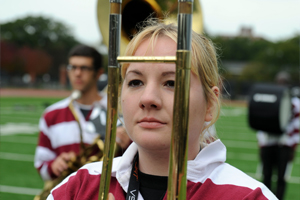Band aid
Students try to drum up support for the Marching Maroons.
By Luke Fiedler, ’10
Photography by Dan Dry
A group of students has brought the Marching Maroons back to Stagg Field, the latest twist in the University band’s long, colorful, and often difficult history. Now featuring more than 20 musicians playing a dozen instruments, the current incarnation made its debut October 16 with performances during the men’s and women’s soccer games.

Farmer presides over the new Maroons.
Getting there wasn’t easy. Treasurer and drummer Ari Epstein, ’11, and other band leaders pursued funding from the University last year, but they had “no critical idea on how to build a marching band.”
There were few instruments and even less information to guide them. Interest in the band has fluctuated through the years, and the lack of continuity has prevented it from becoming an integral part of the campus. “Older members of the University staff feed me cautionary tales of previous band leaders accomplishing much—procuring instruments, city performances, increased membership—without ensuring that underclassmen would maintain it,” Epstein says.
As a first-year in 2007, Epstein joined a “poorly managed, student-run ensemble of about 15 musicians” as its only percussionist. It was a pep band—no marching—that played rock and pop music at football and basketball games.
By last fall there were two drummers—Epstein on a stationary set and another using tenor drums donated by a Missouri high school. Over dinner with band members from Washington University in St. Louis, Epstein asked about how to get the Maroons marching around the football field again. He received one essential piece of advice: “We had to create a drum line.”
With only three days before the Student Government Uncommon Fund’s deadline for funding requests, Epstein, band president Laurel Farmer, and other members composed a formal proposal. They received about $8,000 to acquire percussion equipment.

“More peculiar than precise,” the revived Marching Maroons are back on the beat.
The funds helped the percussion section grow to nine members. By May the group was marching at Summer Breeze and later played at two community events, Art in Action and Relay for Life. “Such a whirlwind of traditional and completely unexpected performances really made my second year at Chicago,” Epstein says.
The whirlwind has whipped up more opportunities. At this past September’s new-student Orientation Week Convocation, the drum line helped lead the procession from Hull Gate to the Henry Crown Fieldhouse practice field for the Class of 2013 photo.
Its football performances continued at the homecoming game October 24 and with a special Halloween show at the October 31 game against Case Western. They had tentative plans to collaborate with the Carnegie Mellon band at the November 14 game.
It was a long road back to the football field. Founded in 1898, the band featured as many as 100 members at the height of its popularity. In its early years the band would use balloons or confetti to add a touch of color to its otherwise traditional performances.
But when the University abolished its football program in 1939, the marching band was left without a team. In the 1960s the football program returned, this time as a nonvarsity club team, sparking a November 1963 sit-in and eventual student riot. Amid all that negative energy, the band found it hard to generate positive buzz.
That difficulty remains. “Unfortunately, years and years of mediocrity reduced the band to being, for instance, the butt of many jokes,” Epstein says. “We were no pep band to some people; we could only be a sad excuse for one.” Epstein considers his challenge bigger than simply reorganizing the band—he wants to reintegrate it into campus culture.
To do so, people first have to recognize the Marching Maroons as a band. Because the group performs in maroon-and-white striped shirts, Epstein says, “people often confuse us as an unusually small Chicago rugby team.” Sartorial mix-ups aside, band leaders are intent on “rebranding ourselves as an exciting addition to the University band legacy.”
An awareness of that legacy does not necessarily mean a blind adherence to tradition. This group welcomes anyone without an audition—any instrument will be accommodated—and the result is, according to its Web site, “more peculiar than precise, more avant-garde than attend-hut.”
And, they believe, more reflective of the student body’s tastes than a conventional marching band—the better to attract an audience and active members to make this attempt at reinvention more than another footnote in its fitful history. “We feel that the best way to be embraced by the current student body is to reflect them, not their grandparents.”
